Canadian Diamonds – Are They Worth the Extra Money?
Read this article in full if you are planning on buying a Canadian diamond.
It’s going to save you money and help you make the best decisions when buying a diamond ring.
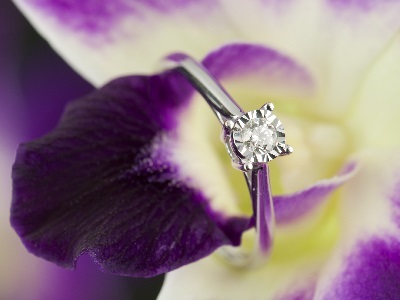
When diamonds were first discovered in Canada during the 1990s, it triggered one of the biggest prospecting rushes in recent history. Fast forward to the present day, Canada has established itself as one of the largest producers of rough diamonds in the world (currently ranked 5th by volume and 3rd by value).
Now, if you had done some jewelry shopping, you probably came across Canadian diamonds being marketed by jewelers as “premium” jewelry products.
So, what’s the deal with these diamonds from Canada?
If you ever wondered whether they are any different from regular diamonds or whether they are worth the money, you are not alone.
Recently, I received a number of emails with recurring questions about Canadian diamonds and it’s about time to clear the air about misconceptions people have and address misleading claims used by jewelers.
Benefits of Buying Canadian Diamonds
Before we delve into deeper details, let’s get down some facts about Canadian diamonds. So, what are some of the benefits of buying a Canada-mined diamond as opposed to buying one that’s mined in another country?
There are basically 3 reasons:
1) Sustainable development and strict environmental laws on mining operations – The Canadian government imposes the toughest regulations on mining companies to protect wildlife, water and fishing habitats of the mining environment.
2) Social benefits and local economic prosperity – The aboriginal communities have benefited from the mining operations with the influx of fair labor jobs and infrastructure development.
3) Accountability and traceability – As soon as the rough diamond is mined, they are tracked through audited processes at every stage production to the end product of a polished stone.
Downsides of Buying a Canada Diamond
Well, there’s actually one main issue with Canadian diamonds – cost.
If you start comparing diamonds from Canada against those from other countries like Russia or Africa, you will quickly see that Canadian diamonds are significantly more expensive (usually 10-20% more).
There are quite a number of factors behind this…
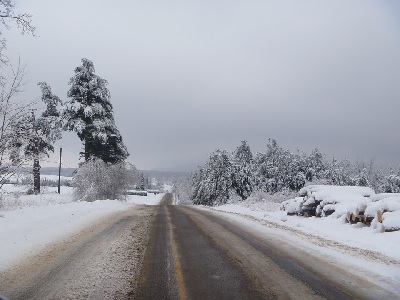
Firstly, mining in the Northwest Territories is a huge challenge because of harsh arctic conditions. The mining operations require specialized machinery and costly equipment. There are no proper roads leading to the remote mine locations and logistics have to be performed in dangerous conditions via ice roads (History channel created a TV series called Ice Road Truckers about the people who perform the supply delivery).
Secondly, concessions and tariffs are imposed onto the mining companies by the Canadian government. The higher labor costs and employee benefits also contribute to higher operation expenses.
Thirdly, there are additional costs involved with the tracking and certification process. Because of the way Canadian diamonds are marketed for transparency, each step of the manufacturing process has to be audited.
At the end of the day, the consumer is expected to pick up the bill as these costs will be factored into the retail pricing of the diamond products.
Debunking Misleading Statements And Marketing Claims
Now, I want to go on record saying that I don’t have anything against diamonds originating from Canada. In fact, I respect and applaud the laws laid down by the government to ensure sustainable mining practices.
What I do have a beef with, is the way diamonds are marketed to consumers by end retailers. Here are the 4 most common misconceptions people have and marketing tricks that salespeople use to mislead consumers…
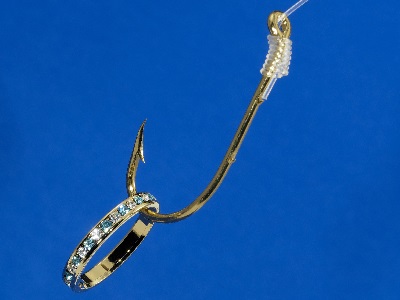
#1 – Canadian Diamonds Are “More Beautiful” And “Have Better Quality”
Blanket statements like this are commonly used by salespeople to market Canadian diamonds in better light and to justify the higher prices they are charging.
Well, let me tell you that such statements are complete rubbish and misleading.
The fact is, it doesn’t matter where it originated from… a diamond is a diamond.
Just like rough diamonds mined in other parts of the world, Canadian roughs also come in all types of shapes, clarity, color and carat sizes.
Diamonds are graded individually by the 4Cs and this is how their quality/value is determined in the market. If a polished Canadian diamond has been graded by GIA to be 0.5 carat, G color and VS2 clarity, its “quality” is no different from another diamond mined in Botswana that’s graded to be 0.5 carat, G color and VS2 clarity.
If you follow along the lines of the same argument, a high quality D color VVS1 diamond from another mine is going to be better than a poor quality L color I2 diamond from Canada.
While I find the idea of a diamond that originated from the Arctic regions of Canada to be romantic, I don’t see the need to pay more for them because of practical reasons. Why should I pay 15%-20% more for a Canadian diamond when I can get an identical diamond from another legitimate mining operation at cheaper prices?
#2 – Jeweler Says a CanadaMark Diamond is Guaranteed to be Beautiful
If someone says that to you in an attempt to convince you to buy CanadaMark diamond jewelry, you better think twice because that person is BSing you.
First of all, what’s a CanadaMark Diamond?
CanadaMark is an origin hallmark program created by the owners of the Canadian mines to track and document diamonds that are produced in Canada.
The following quote basically summarizes what CanadaMark is all about:
“The CanadaMark program represents the company’s commitment to category marketing of Canadian diamonds,” said chairman and CEO Robert Gannicott. “Through this program, the company aims to highlight the long-term environmental stewardship and social responsibility of the Canadian diamond mining industry, which ultimately will help achieve the highest prices for the company’s diamond production.”
Yep. You heard it straight from the horse’s mouth.
The CanadaMark program is nothing more than a marketing strategy to brand Canadian mined diamonds and to sell them for higher profits. It has nothing to do with guaranteeing a diamond’s “beauty”.
The problem is that many jewelry retailers use the hallmark as a misleading sales tool. In fact, many unsuspecting customers simply assume that a CanadaMark diamond has to undergo strict selection processes.
The truth is, it is anything but stringent.
Did you know that the CanadaMark can be used on polished diamonds with a cut grade of Very Good or better, L color or higher and I2 clarity or higher?
Here’s the kicker…
Round diamonds with a “Very Good” cut grade simply imply a mediocre cut quality. There are literally hundreds of thousands of diamonds exhibiting a similar low level of cut quality in the market today.
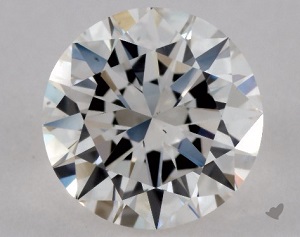
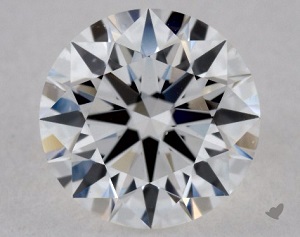
A comparison of a Very Good Cut CanadaMark Diamond vs. a diamond cut for light performance.
In case you don’t know yet, diamonds in the G-L color range aren’t rare nor are they perceived as high “quality”. In fact, most jewelry businesses won’t even consider selling L colored diamonds because of their yellowish tints.
Lastly, the fact that CanadaMark allows a bottom of the barrel I2 clarity grade reveals a lot about their quality standards. Personally, I would never recommend an I2 diamond to anyone in good faith and that should give you an idea of how bad it is.
The bottomline is, you shouldn’t blindly believe the marketing fluff just because the sales person told you so. Most salespeople are there to sell you stuff without placing your interest as the top priority.
#3 – The “Conflict Free” Guarantee – What’s the Big Hoo Haa About?
I absolutely hate it when companies that actively market Canadian diamonds harp on the issue of conflict diamonds as if Canada is the exclusive source of “conflict free” diamonds.
Don’t get me wrong, conflict diamonds were a serious issue back in the early 2000s. However, the civil war in Sierra Leone is long over and the collective effort of international communities to implement the Kimberly Process has curtailed the sale of conflict diamonds since.
From my personal shopping experience (as well as those by other readers), it feels like jewelers who market Canadian diamonds often do so by taking advantage of people’s emotions that conflict diamonds are still prevalent in the current market.
This is plain wrong.
In reality, it’s impossible to buy a “blood diamond” even if you want to. The Kimberley Act established in 2003 has leveled the playing field in the trade by ensuring that rough diamonds only come from legitimate sources.
Besides, there isn’t a single jeweler that I know of who doesn’t comply with the Kimberly Process. Whether a diamond is mined from Australia, Africa, Russia or Canada, you can be assured that the diamond is conflict free.
#4 – Certified Canadian Diamonds Offer the Best Sparkle And Brilliance
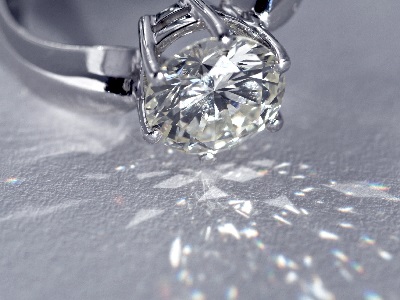
There are a number of jewelers (some big brands are guilty of this as well) and “experts” who market Canadian diamonds as premium products that offer the best “fire and brilliance” because of their material properties.
In my experience, these are usually marketing gimmicks that fall short on expectations as soon as you perform some analysis and apply basic common sense.
The beauty and overall appearance of a diamond is influenced largely by CUT and has nothing much to do with its origins. Whether a diamond is mined in Canada or in Africa, a skilled cutter is required to bring out the true beauty of the rough.
For readers who had been following my blog, you will know I’m an advocate for cut quality and take on a scientific approach to analyze diamonds. In essence, sparkle and brilliance of a diamond are my utmost priorities when I buy diamonds.
With the current standards of the Canadian cutters and polishers, I can tell you that it’s extremely unlikely to find a Canadian cut diamond that passes my standards to be purchase worthy.
To illustrate this, here are some examples to give you an idea of the typical cut quality you can expect…
Read this to find out why they aren’t the kind of diamonds I would buy.
Now, I’m not saying that well cut Canadian diamonds don’t exist but finding them is like searching for a needle in a haystack. They are extremely rare and difficult to source for.
To show you the kind of cut standards you should be looking for, here’s one example I found on Brilliant Earth…
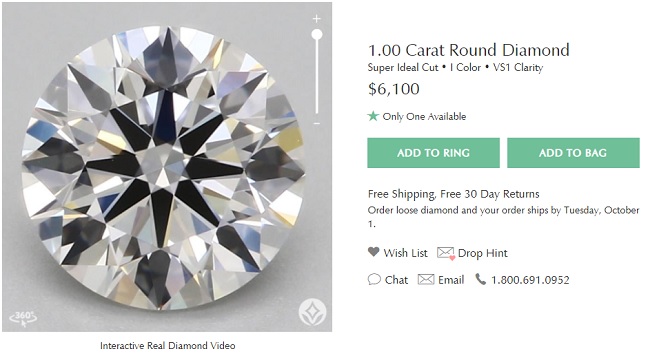
1.00 Carat Round Diamond Super Ideal Cut • I Color • VS1 Clarity
If you are looking for a truly well cut diamond with super ideal standards, you will need to get educated and understand the details that go into cherry picking one. Even then, expect to fork out a huge premium for stones from Canada.
Where is the Best Place to Buy Canadian Diamonds Engagement Rings?
If you made the final decision to buy a Canadian diamond engagement ring, the next question on your mind is probably where to start looking. Who can you trust to reliably deliver a high quality engagement ring?
To get you started, these are 3 companies I recommend for their range of loose diamond selections, exemplary customer service and excellent craftsmanship on finished jewelry products.
James Allen – CanadaMark Diamond Vendor With Videos

Click here to view James Allen’s entire inventory of CanadaMark™ diamonds…
James Allen is one of the best places to shop for a diamond engagement ring because of their vivid 360° videos. The high definition videos will enable you to scrutinize the smallest details and cherry pick the perfect diamond.
Brilliant Earth – The World’s Largest Online Diamond Jewelry Retailer
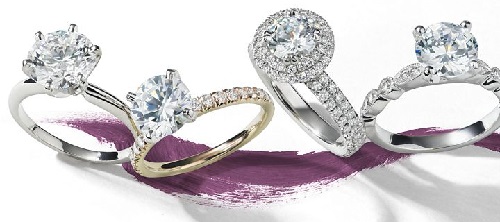
Click here to browse Brilliant Earth’s inventory of Canada-mined diamonds…
Brilliant Earth is the pioneer in selling conflict free diamond jewelry online and they have a sizable range of certified diamonds from Canada. If you are looking for diamonds that have better cut quality and light performance, check out their signature diamond series.
Conclusion – Should You Buy a Canadian Diamond?
At the end of the day, it boils down to personal preferences and your own belief system. Whether it is worth it to pay the premium for a Canada diamond is something that’s subjective to different people.
My advice to you is to evaluate individual diamonds on their own merit and to look beyond the marketing fluff that jewelers will feed you just to close a deal.
Good luck with your engagement ring search!
If you have any questions, feel free to get in touch via email or simply drop a comment below. I would love to hear your opinions about buying Canadian diamonds.
Leave A Comment

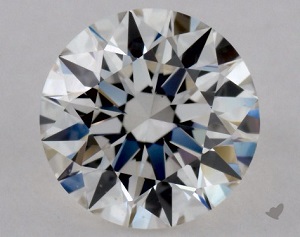
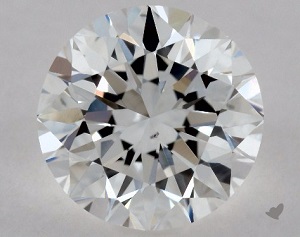









31 Comments
As requested by some readers via email, here are some reference links that you can use to find out more about the Canadian diamond mining industry:
https://www.iti.gov.nt.ca/en/services/government-certified-canadian-diamond%E2%84%A2
http://www.canadiandiamondcodeofconduct.ca/
https://www.fraserinstitute.org/categories/mining
http://thegreenerdiamond.org/conflict-diamonds-2/environmental-impact/
https://www.gov.nt.ca/
https://www.npr.org/templates/story/story.php?storyId=96564952?storyId=96564952
These links talks about a recent discovery of the largest Canadian diamond that was found: https://www.canadianbusiness.com/lists-and-rankings/best-stocks/lucara-diamond-lesedi-la-rona/
https://www.bloomberg.com/news/features/2016-05-18/freakish-diamond-pulled-from-sub-arctic-ice-is-about-to-go-on-sale
Current economics and mining updates:
https://www.reuters.com/article/us-canada-diamonds-idUSKCN0SL0CR20151027
http://www.miningmarkets.ca/news/canadian-diamond-exploration-perks-up/
https://www.wsj.com/articles/SB10001424127887324735104578117021061932576
My husband brought me an anniversary ring many years back and the ring has an inscription of a polar bear on the diamond. He paid $7,000 it and I believe it is a branded Canadian trademark called the Polar Bear Diamond.
At the moment, I am trying to upgrade my diamond ring one with a larger carat size. I tried to sell the ring to a local jeweler but he is only willing to pay $3,000 for it. It seems like a low ball offer and the accompanying documents I have stated the ring to be worth $9,000. I thought a branded piece of jewelry should be able to hold its value instead of being depreciated by such a huge amount. Why is this resale value so cheap?
At its peak (before the market crash of 2008), the economy was doing very well and this sprouted a series of Canadian diamond companies that tried to differentiate themselves through name branding.
Here’s a list of diamond brands that existed at that time Some of these brand names carried a trade logo such as a maple leaf, CanadaMark symbol, polar bear or phrases like “Ice on Fire”:
CANADIAN ARCTIC
Eskimo Arctic Ice
AURIAS and AURIAS Select
Hallmark of Quality Canadian Diamonds
Igloo Diamonds
Polar Ice Diamonds
Canadian Ice Diamonds http://canadianicediamonds.ca/
Fire and Ice Canadian Diamond https://www.beverlyhillsjewellers.ca/
Canada Goose Diamonds http://www.canadagoosediamond.com
Gacier Fire https://charmdiamondcentres.com/
Tundra Canadian Diamonds
Celebration Canadian Fire Diamond
NENOIR
Polar Bear Diamonds
*Note that some of these businesses are no longer operational and had closed down.
As you can see, a brand name is nothing more than a marketing attempt to differentiate the diamonds sold by a business from another competitor. It doesn’t make the diamond more “valuable” and the number stated in the appraisal report is just a feel good factor for consumers.
You really shouldn’t expect to sell the ring at the price listed in the report back to the jeweler. The reality is, if you can even get back half of what it cost you to buy the ring, you can count your lucky stars. Without looking at further details, I would say that the offer isn’t low ball and is typical of what you can expect someone to pay for a second hand item. If you want to get a better price, try selling it yourself on eBay or Craigslist.
Great article! I’m a local Canadian and I want to do my part in supporting the local community. I am planning to propose to my girlfriend of 5 years during the Christmas period and want to buy a 100% made in Canada diamond engagement ring. Have you heard of the Celebration Canadian Fire rings from Peoples Jewellers?
Yep. I have heard of them but I’m not so sure whether Celebration Diamonds are cut using rough stones that are mined in Canada.
This should provide more information: https://beyond4cs.com/reviews/zales/celebration-diamonds/
Branded diamonds are expensive because of the premium placed on them. As for supporting the local workers and communities, I am not too sure how much of the money you pay for a diamond ring actually gets through the pipeline to the community.
I would recommend checking out BlueNile. They are a respectable business and offer a variety of ring designs. I’m not a fan of the Canadian Ice diamond series because of the grading report they use. The Global Gemological Institute certificate of authenticity is not a reliable one that I would trust to accurately represent the quality of the diamond. Stick with GIA/AGS graded loose diamonds.
Great stuff! I was thinking of getting a matching set of Canadian wedding ring when I came across your website. Finally, I understand why Canadian diamonds are more expensive now. Despite their prices, they are not necessary the better or best option compared to other diamonds.
Thank you SOOOOOOOOO much for writing this article. I live in the UK and visited a jeweller in Hatton Garden recently. She was telling me that there was a big difference in Canadian diamonds vs African diamonds and actually showed me 2 diamonds side by side. We did a blind test because she wanted to prove that a Canadian diamond was better. And as it turns out, the brighter diamond was a CanadianMark diamond. When I asked to see the grading report for both diamonds, it turns out that the other stone used in the blind test was a G Good cut diamond by GIA. In contrast, the CanadaMark diamond is rated to be Excellent. I finally figured out why after reading this article and suspect she had a hidden agenda to push for the more expensive diamond.
Well, you aren’t comparing apples to apples. The origin of the stone doesn’t affect sparkle and brightness as much as a diamond’s cut does.
I have a small budget of CAD2,000 for my engagement ring. Is there any wholesale canadian diamond supplier that you can recommend?
Well, beware of jewelers who claim they are wholesalers: https://beyond4cs.com/engagement-ring/beware-of-cheap-diamond-deals/
I don’t know any Canadian diamond wholesaler who would deal directly with the public. If they did, they would have been called a retailer instead of a wholesale business.
I’ve visited a number of local jewelry stores in Toronto but the prices they are charging are way too high. After reading your articles, I’m convinced of getting one from the Internet. Do you have any websites selling engagement rings in Canada online? Also, what do you think of the Canadian ice diamond?
I still don’t get the difference between Canadian diamonds vs. regular diamonds. Are you saying they are more expensive because of marketing and mining costs?
They cost more because of a combination of factors. Downstream labor costs in transportation, polishing fees, retail fees, government taxes and etc all account for higher prices.
The end of the article references 3 places to buy, but only 2 are listed…Do you have a 3rd recommendation?
The 3rd company is Brilliant Earth. There were some edits to the blog posts and a portion of it was mistakenly removed. Thanks for highlighting this!
Hi Paul.
I wanted to just stress an important aspect of CanadaMark diamonds.
Since Serendipity Diamonds was one of the first companies to introduce CanadaMark diamonds into the UK for trade and for members of the public. Furthermore, we were also the first to offer a supply of CanadaMark melee diamonds. We have spent an extensive amount of time introducing responsible sourcing into our work.
Our reason for introducing CanadaMark is that such diamonds go beyond the usual conflict-free assurances provided with most diamond sales. It is not just the ‘Blood Diamond’ issue that is a concern.
You noted that in reality, it’s impossible to buy a “blood diamond” even if you want to.
But a very important note is that many ‘Conflict-Free’ diamonds coming from legitimate governments fail to observe basic human rights.
The human rights issue is a very hot topic that needs to be brought into the open.
CanadaMark diamonds give a further assurance that goes beyond the Kimberley Process. Environmental stewardship, personal welfare for workers and community support all complement the traceability and ethical credentials provided by CanadaMark diamonds.
I could write so much more on this topic, but wanted to just add to the discussion with a few important details.
Best wishes, Mark.
Without naming names, since I don’t want to be accused of promoting any one company, another thing “certain” Canadian Diamonds have is a serial number laser inscribed on them. This can be included on the appraisal in case of theft. I think you alluded to that, but I just wanted to come right out and say it. I really like that.it might not seem like much but I like that.
Or is it inscribed inside the diamond, I’m not 100% sure. But I know it’s there.
@Diamond Lover: The number is on the girdle (outer edge of the diamond). Another thing that I’d like to point out is that you need to make sure that the numbers are visible and didn’t get placed under the prongs while it was being set.
Paul makes some valid arguments but fails to mention that the diamonds are 100% traceable back to the mine it came from. Other diamonds are not traceable. They might or might not be “blood diamonds” but all that human rights in those parts of the world don’t mean much to them. I’ll take a Canadian diamond ANYDAY over the others, even at a premium price. At least, I can sleep at night like a baby!
There is a lot wrong with your statement “In reality, it’s impossible to buy a “blood diamond” even if you want to. The Kimberley Act established in 2003 has leveled the playing field in the trade by ensuring that rough diamonds only come from legitimate sources.
Besides, there isn’t a single jeweler that I know of who doesn’t comply with the Kimberly Process. Whether a diamond is mined from Australia, Africa, Russia or Canada, you can be assured that the diamond is conflict free.”
The Kimberley Process Certification Scheme itself defines a conflict diamond SOLELY as “rough diamonds used to finance wars against governments.” That is it. That is EXTREMELY limited in its definition. It is absolutely possible to buy a blood diamond today. Please do more research on this subject.
If you think my research is wrong, show me your proof and evidence on where there are wars being raged against governments with financial support coming from the sale of rough diamonds in present time. Try as I might, I tried means to find and don’t have access to networks that peddle blood diamonds. That’s coming from someone in the industry but I don’t profess to know exactly where someone can simply buy a blood diamond. And you clearly disagree with that. So, please point me at the source where someone can purchase an illegal blood diamond in 2019 and I will stand corrected.
To say that it’s impossible to find a blood diamond is completely far fetched and then to add, “point me to a source where someone can purchase a blood diamond in 2019” shows a lack of awareness.
If a topic is not readily available on the internets or it hasn’t been blogged about does not prove it isn’t happening. Numerous human rights conflicts happen around the world daily which aren’t been broadcasted on social outlets, however this does not mean they don’t exist.
Perhaps it’s because you aren’t Canadian that you don’t grasp this country’s importance on supporting its economy, the welfare of the miners and the protection of its ecosystem.
So, in fact, it does matter where a diamond originated from. You can’t have champagne taste on a milk budget
I’m not a Canadian but that doesn’t mean I don’t understand or know what environmental issues mean for the government and the public. The Ekati mine has some of the most stringent mining rules and environmental regulations in the world. And for the record, I do respect what the Canadian government is doing. What I’m not OK with is when downstream unethical jewelers market Canadian diamonds with inaccurate statements.
BUT, what does Canada’s economy or environmental issues have anything to do with blood diamonds?
It’s a totally different topic all together.
You probably want to find out what a blood diamond is and what it means. You claim there are “numerous human rights conflicts” happening around the world daily and insinuating that they are caused by blood diamonds. Across the networks that I have access to, I can’t buy a diamond that is of blood diamond origins.
Since you claim otherwise, all I’m asking for is your proof to back that up. Can you show me and the rest of the readers on this blog some examples of where there are “daily human rights conflicts” which are funded by blood diamonds?
I will be the first to admit I’m wrong, apologize and make corrections to this article if you can show without a shadow of doubt that there are currently blood diamonds being sold and the money is traceable back to funding conflicts.
Thanks for the information! I am looking for an AGS 0 Ideal cut diamond from Canada…Is Ikuma from Ben Bridge reliable for this or do you have any other recommendations?
thank you!
I have no prior experience or made personal purchases of the Ikuma rings from them to offer any indepth insights. But since they have a 3rd party AGS report to go along with their diamond rings, that’s a good start. I would just caution that you still need to be selective of the diamonds for their cut quality and performance. If you want to be sure, then request for the hearts and arrows images on top of ASET scope images to better assess the diamond you are intending to buy.
Hi Paul.. I have had Celebration diamonds for years with Peoples and they have 100 facets. My 1.12 Canadian solitaire also has 100 facets and holding this ring in all different lights sparkle better than other diamond rings compared. It is an F color SI1 and the anniversary bands on each side are E color and SI2. I have had so many compliments as they sparkle from a distance. I also like the idea that Canadian diamonds are numbered on the shanks as you know truthfully what you are getting compared to other diamonds that you do not know what you are buying. Deborah K
ontop of the higher wages being paid for canadian labour. Canadian diamonds are also very hard compared to diamonds from other countries, and can take more than twice as long to cut the diamonds. If the diamond is being cut in Canada labour costs will be much more because of the extra time to cut and higher wages.
I think you meant to say that a Canadian rough is more difficult to polish? On the contrary, no. Canadian roughs tend to be better in quality (less inclusions) and should allow for easier planning. I will caution here and emphasize that this is only in general. Rough diamonds come in all kinds of shapes and quality and depending on the type of goods a cutter is working with, they will get different results and yield. Also, you are correct to say that labor costs more in Canada than in India.
As others mentioned above Paul, your article is definitely misleading about conflict-free diamonds and the Kimberley process. The Kimberley Process is defined as “rough diamonds used to finance wars against governments” and that is it. You seem to be very defensive and asking people where the proof is that someone can buy a “blood diamond” today, but you are missing the much bigger issue. The Kimberley Process definition does not include forced labor (even of women and children), labor violations like workplace injury and death, inhumane working conditions, and money laundering. These all absolutely exist today and if you do not believe that then you are deliberately choosing to shut your eyes to these atrocities. Since you seem to know everything about diamonds (that’s sarcasm), you should already be aware of the rough diamond trade, but in any case I will lead you to Martin Rapaport’s presentation, and I hope you watch the entire thing. https://www.youtube.com/watch?v=F5uPqk1tFD8&t=2852s
What has blood diamonds got to do with “labor violations like workplace injury and death, inhumane working conditions and money laundering”? These are separate issues altogether. At the time of writing, please show me how you can buy blood diamonds in the market and when I say this, I refer to common sources like your mom and pop jeweler who isn’t pedaling Canadian sourced diamonds. But given the Russian invasion of Ukraine, I would concede that blood diamonds do exist now in the market and had been. Anyone who had bought a Russian-sourced diamond before 2022 would have contributed to the war efforts. That should also be said to everyone in the European country, US and around the world who used any form of fuel/gas sourced from Russia.